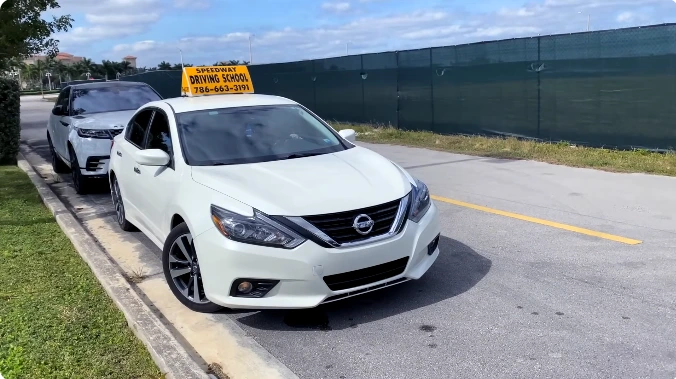Mastering Driving Skills & Acing Your Driving Test!
A beginner’s guide to learning to drive a car and passing your driving test successfully includes essential steps and tips for beginners. This guide provides valuable information on learning the basics of driving, understanding road signs and rules, developing safe driving habits, and preparing for the driving test.
By following this guide and practicing consistently, beginners can gain confidence, improve their driving skills, and increase the chances of passing the driving test successfully.
Understanding The Basics
Getting Familiar With The Vehicle
Before you start learning to drive, it’s crucial to get familiar with the vehicle you’ll be driving. Here are some key points to keep in mind:
- Take the time to sit in the driver’s seat and adjust your seat and mirrors so that you’re comfortable and have a clear view of the road.
- Familiarize yourself with the dashboard and understand what each of the gauges and warning lights mean. This will help you monitor the vehicle’s performance and safety features.
- Get to know the basic controls of the car, such as the accelerator pedal, brake pedal, and steering wheel. Practice using these controls to develop a sense of how the car responds.
- Locate the gear shift and become familiar with the different gears, especially if you’ll be driving a manual transmission. Understanding how to shift gears is essential for controlling the speed and power of the vehicle.
Learning Traffic Laws And Regulations
To become a safe and responsible driver, it’s crucial to have a solid understanding of traffic laws and regulations. Here are some key points to help you navigate the rules of the road:
- Study your state or country’s driver’s manual to familiarize yourself with the traffic laws specific to your region. This will cover everything from speed limits to road signs and signals.
- Learn about right-of-way rules and how to navigate intersections safely. Understanding who has the right of way in different situations will help you make informed decisions while driving.
- Study and understand the various road signs and signals you’ll encounter. It’s vital to know what each sign means to follow directions and stay safe on the road.
- Educate yourself on parking regulations and restrictions in your area. Knowing where and when you can park will help you avoid unnecessary fines or inconveniences.
Mastering Vehicle Controls
Once you’re familiar with the basics of the vehicle and have a good grasp of traffic laws, it’s time to focus on mastering the vehicle controls. Here are some key points to consider:
- Practice starting and stopping the car smoothly. This includes smoothly releasing the clutch pedal (if driving a manual) or applying gradual pressure to the accelerator pedal (if driving an automatic).
- Learn how to steer the vehicle with precision. Practice turning corners and maintaining your lane position while keeping a safe distance from other vehicles.
- Develop your braking skills by practicing gradual and controlled stops. Understand the difference between regular braking and emergency braking and how to perform both effectively.
- Familiarize yourself with additional vehicle controls such as the windshield wipers, headlights, and horn. Knowing how to operate these features will ensure your safety and the safety of others on the road.
Developing Essential Driving Skills
Learning to drive a car is an exciting adventure that opens up a world of possibilities. As a beginner, it’s important to focus on developing essential driving skills to ensure a smooth and successful journey towards obtaining your driver’s license.
In this section, we will explore three key areas that are crucial for every aspiring driver to master: navigating different traffic situations, practicing safe and defensive driving, and refining parking and maneuvering techniques.
Navigating Different Traffic Situations
When it comes to navigating different traffic situations, it’s essential to understand the various challenges you may encounter on the road. Here are some key points to keep in mind:
- Understanding road signs and markings: Familiarize yourself with the meaning of different road signs and markings. They provide valuable information and instructions that will help you navigate the roads safely.
- Adapting to different road conditions: Be prepared to adjust your driving style based on weather conditions, road construction, and congestion. This flexibility will ensure you can handle any situation that arises.
- Interacting with other drivers: Practice good communication by using turn signals, observing right-of-way rules, and maintaining a safe distance from other vehicles. Being attentive and respectful towards other drivers will promote a smooth flow of traffic.
Practicing Safe And Defensive Driving
Safety should always be your top priority when behind the wheel. Here are some essential points to remember when practicing safe and defensive driving:
- Maintaining proper speed and following distance: Adhere to the posted speed limits and maintain a safe following distance from the vehicle ahead. This will give you ample time to react to any unexpected changes in traffic.
- Anticipating potential hazards: Stay alert and scan the road ahead for any potential hazards, such as pedestrians, cyclists, or aggressive drivers. Being proactive in recognizing potential dangers will enable you to react swiftly and avoid accidents.
- Avoiding distractions: Keep your focus solely on the road and eliminate any distractions, such as using your phone or adjusting the radio. Distracted driving is a leading cause of accidents and should be avoided at all costs.
Refining Parking And Maneuvering Techniques
Mastering parking and maneuvering techniques is essential for successfully navigating tight spaces and parking lots. Here are some key techniques to refine:
- Parallel parking: Practice parallel parking in various scenarios to develop confidence and precision. Remember to use your mirrors effectively and take it slow and steady.
- Navigating tight turns: Learn how to execute tight turns, such as u-turns and three-point turns, with precision. Take your time and use your vehicle’s full range of motion to navigate these maneuvers smoothly.
- Backing up safely: Develop a good understanding of how to reverse your vehicle while maintaining proper visibility. Utilize your mirrors and, if necessary, ask for assistance to ensure you navigate backward safely.
By dedicating time and effort to developing these essential driving skills, you will build a solid foundation for a successful driving journey. Remember to practice regularly, remain patient, and never stop learning. Safe travels!
Preparing For The Driving Test
Preparing for your driving test is crucial to increase your chances of passing successfully. It requires a combination of understanding the test requirements, practicing mock driving tests, and managing test anxiety. In this section, we will explore each of these key points in detail.
Understanding The Test Requirements
To prepare effectively for your driving test, it’s important to familiarize yourself with the test requirements. Here are some key points to keep in mind:
- Learn the rules of the road: Review and understand the rules and regulations of driving in your area. This includes traffic signs, speed limits, right-of-way rules, and more.
- Study the driving manual: Obtain a copy of the driving manual provided by your local dmv or licensing authority. Thoroughly go through the manual to gain a comprehensive understanding of the driving laws and regulations.
- Know the test format: Research and understand the format of the driving test. This may include both a written exam and a practical driving test. Be aware of the specific skills and maneuvers that you will be assessed on.
Practicing Mock Driving Tests
Practice makes perfect, and this is especially true for preparing for your driving test. Here are a few tips for effective practice:
- Enroll in a driving school: Consider enrolling in a driving school for professional guidance and structured lessons. This will help you build a solid foundation of driving skills and techniques.
- Practice with a licensed adult: If you have the opportunity, practice driving with a licensed adult who can provide guidance and assistance. Focus on improving skills such as parking, turning, and merging.
- Utilize online resources: Take advantage of online resources that offer mock driving tests. These practice tests will help you become familiar with the types of questions and scenarios you may encounter during the exam.
Managing Test Anxiety
Test anxiety is common, but it can be managed effectively with the right approach. Here are a few strategies to help you stay calm and focused:
- Be well-prepared: The more prepared you are, the more confident you will feel on the day of the test. Dedicate ample time to practice and revision, ensuring you are comfortable with all aspects of driving.
- Get a good night’s sleep: Adequate rest is essential for optimal cognitive function. Make sure to get a good night’s sleep before your driving test to help you stay alert and focused.
- Control your breathing: Deep breathing exercises can help relax your mind and reduce anxiety. Practice taking slow, deep breaths before and during the test to help calm your nerves.
- Visualize success: Visualize yourself passing the driving test successfully. Positive visualization can boost your confidence and create a positive mindset.





